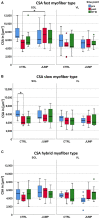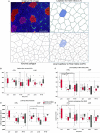Reactive Jumps Preserve Skeletal Muscle Structure, Phenotype, and Myofiber Oxidative Capacity in Bed Rest
- PMID: 32009969
- PMCID: PMC6974579
- DOI: 10.3389/fphys.2019.01527
Reactive Jumps Preserve Skeletal Muscle Structure, Phenotype, and Myofiber Oxidative Capacity in Bed Rest
Abstract
Identification of countermeasures able to prevent disuse-induced muscle wasting is crucial to increase performance of crew members during space flight as well as ameliorate patient's clinical outcome after long immobilization periods. We report on the outcome of short but high-impact reactive jumps (JUMP) as countermeasure during 60 days of 6° head-down tilt (HDT) bed rest on myofiber size, type composition, capillarization, and oxidative capacity in tissue biopsies (pre/post/recovery) from the knee extensor vastus lateralis (VL) and deep calf soleus (SOL) muscle of 22 healthy male participants (Reactive jumps in a sledge, RSL-study 2015-2016, DLR:envihab, Cologne). Bed rest induced a slow-to-fast myofiber shift (type I ->II) with an increased prevalence of hybrid fibers in SOL after bed rest without jumps (control, CTRL, p = 0.016). In SOL, JUMP countermeasure in bed rest prevented both fast and slow myofiber cross-sectional area (CSA) decrements (p = 0.005) in CTRL group. In VL, bed rest only induced capillary rarefaction, as reflected by the decrease in local capillary-to-fiber ratio (LCFR) for both type II (pre vs. post/R + 10, p = 0.028/0.028) and type I myofibers (pre vs. R + 10, p = 0.012), which was not seen in the JUMP group. VO2 max Fiber (pL × mm-1 × min-1) calculated from succinate dehydrogenase (SDH)-stained cryosections (OD660 nm) showed no significant differences between groups. High-impact jump training in bed rest did not prevent disuse-induced myofiber atrophy in VL, mitigated phenotype transition (type I - >II) in SOL, and attenuated capillary rarefaction in the prime knee extensor VL however with little impact on oxidative capacity changes.
Keywords: bed rest; capillarization; countermeasure; disuse; muscle atrophy; oxidative capacity.
Copyright © 2020 Blottner, Hastermann, Weber, Lenz, Gambara, Limper, Rittweger, Bosutti, Degens and Salanova.
Figures




Similar articles
-
Whey protein with potassium bicarbonate supplement attenuates the reduction in muscle oxidative capacity during 19 days of bed rest.J Appl Physiol (1985). 2016 Oct 1;121(4):838-848. doi: 10.1152/japplphysiol.00936.2015. Epub 2016 Aug 11. J Appl Physiol (1985). 2016. PMID: 27516541 Clinical Trial.
-
Capillary rarefaction during bed rest is proportionally less than fibre atrophy and loss of oxidative capacity.J Cachexia Sarcopenia Muscle. 2022 Dec;13(6):2712-2723. doi: 10.1002/jcsm.13072. Epub 2022 Sep 13. J Cachexia Sarcopenia Muscle. 2022. PMID: 36102002 Free PMC article.
-
Human skeletal muscle structure and function preserved by vibration muscle exercise following 55 days of bed rest.Eur J Appl Physiol. 2006 Jun;97(3):261-71. doi: 10.1007/s00421-006-0160-6. Epub 2006 Mar 28. Eur J Appl Physiol. 2006. PMID: 16568340 Clinical Trial.
-
Differential expression of nitric oxide synthases (NOS 1-3) in human skeletal muscle following exercise countermeasure during 12 weeks of bed rest.FASEB J. 2004 Aug;18(11):1228-30. doi: 10.1096/fj.03-0792fje. Epub 2004 Jun 4. FASEB J. 2004. PMID: 15180967 Clinical Trial.
-
High-Intensity Jump Training Is Tolerated during 60 Days of Bed Rest and Is Very Effective in Preserving Leg Power and Lean Body Mass: An Overview of the Cologne RSL Study.PLoS One. 2017 Jan 12;12(1):e0169793. doi: 10.1371/journal.pone.0169793. eCollection 2017. PLoS One. 2017. PMID: 28081223 Free PMC article. Clinical Trial.
Cited by
-
Implementation of exercise countermeasures during spaceflight and microgravity analogue studies: Developing countermeasure protocols for bedrest in older adults (BROA).Front Physiol. 2022 Aug 9;13:928313. doi: 10.3389/fphys.2022.928313. eCollection 2022. Front Physiol. 2022. PMID: 36017336 Free PMC article. Review.
-
Spaceflight on the ISS changed the skeletal muscle proteome of two astronauts.NPJ Microgravity. 2024 Jun 5;10(1):60. doi: 10.1038/s41526-024-00406-3. NPJ Microgravity. 2024. PMID: 38839773 Free PMC article.
-
Nitrosative Stress in Astronaut Skeletal Muscle in Spaceflight.Antioxidants (Basel). 2024 Apr 2;13(4):432. doi: 10.3390/antiox13040432. Antioxidants (Basel). 2024. PMID: 38671880 Free PMC article.
-
Space Omics and Tissue Response in Astronaut Skeletal Muscle after Short and Long Duration Missions.Int J Mol Sci. 2023 Feb 17;24(4):4095. doi: 10.3390/ijms24044095. Int J Mol Sci. 2023. PMID: 36835504 Free PMC article.
-
The State of the Art of Piezo1 Channels in Skeletal Muscle Regeneration.Int J Mol Sci. 2022 Jun 14;23(12):6616. doi: 10.3390/ijms23126616. Int J Mol Sci. 2022. PMID: 35743058 Free PMC article. Review.
References
LinkOut - more resources
Full Text Sources
Miscellaneous

